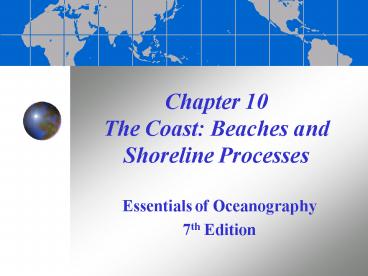Chapter 10 The Coast: Beaches and Shoreline Processes - PowerPoint PPT Presentation
1 / 25
Title:
Chapter 10 The Coast: Beaches and Shoreline Processes
Description:
Light wave activity moves sand up the beach face toward the berm ... Seawalls can destroy recreational beaches. Seawalls are costly and eventually fail ... – PowerPoint PPT presentation
Number of Views:693
Avg rating:3.0/5.0
Title: Chapter 10 The Coast: Beaches and Shoreline Processes
1
Chapter 10 The Coast Beaches and Shoreline
Processes
- Essentials of Oceanography
- 7th Edition
2
Landforms and terminology in coastal regions
Figure 10-1
3
Movement of sand on the beach
- Movement perpendicular (?) to shoreline
- Caused by breaking waves
- Light wave activity moves sand up the beach face
toward the berm - Heavy wave activity moves sand down the beach
face to the longshore bars - Produces seasonal changes in the beach
4
Light versus heavy wave activity
5
Summertime and wintertime beach conditions
Summertime beach
Wintertime beach
Figure 10-2
6
Movement of sand on the beach
- Movement parallel (?) to shoreline
- Caused by wave refraction (bending)
- Each wave transports sand either upcoast or
downcoast - Huge volumes of sand are moved within the surf
zone - The beach resembles a river of sand
7
Longshore current and longshore drift
- Longshore current zigzag movement of water in
the surf zone - Longshore drift movement of sediment caused by
longshore current
Figure 10-3b
8
Features of erosional shores
- Headland
- Wave-cut cliff
- Sea cave
- Sea arch
- Sea stack
- Marine terrace
Figure 10-4
9
Sea stack and sea arch, Oregon
10
Features of depositional shores
- Spit
- Bay barrier
- Tombolo
- Barrier island
- Delta
Figure 10-7
11
Barrier island, New Jersey
Figure 10-9c
12
Formation of barrier islands
- Sea level rose after the last Ice Age
- Caused barrier islands to roll toward shore like
a tractors tread
Figure 10-10
13
Beach compartments in southern California
- Beach compartments include
- Rivers
- Beaches
- Submarine canyons
Figure 10-12
14
Evidence of emerging and submerging shorelines
- Emergent features
- Marine terraces
- Stranded beach deposits
- Submergent features
- Drowned beaches
- Submerged dune topography
- Drowned river valleys
Figure 10-13
15
Changes in sea level
- Sea level has changed throughout time
- Tectonic and isostatic movements are localized
and change the level of the land - Eustatic changes cause sea level to rise or fall
worldwide and are produced by - Changes in seawater volume
- Changes in ocean basin capacity
16
Sea level has risen since the last Ice Age
- Sea level was 120 meters (400 feet) lower during
the last Ice Age - About 18,000 years ago, sea level began to rise
as the glacial ice melted
Figure 10-14
17
Relative sea level rise at New York City
- Sea level has risen 40 centimeters (16 inches)
since 1850 - Global warming is predicted to increase the rate
of sea level rise
Figure 10-15
18
U.S. coastal erosion and deposition
Figure 10-16
19
Types of hard stabilization
- Hard stabilization perpendicular to the coast
within the surf zone - Jettiesprotect harbor entrances
- Groinsdesigned to trap sand
- Hard stabilization parallel to the coast
- Breakwatersbuilt beyond the surf zone
- Seawallsbuilt to armor the coast
20
Jetties and Groins
- Jetties are always in pairs
- Groins can be singular or many (groin field)
- Both trap sand upstream and cause erosion
downstream
Figure 10-21
21
Breakwater at Santa Barbara Harbor, California
- Provides a boat anchorage
- Causes deposition in harbor and erosion
downstream - Sand must be dredged regularly
Figure 10-22
22
Seawalls and beaches
- Seawalls are built to reduce erosion on beaches
- Seawalls can destroy recreational beaches
- Seawalls are costly and eventually fail
Figure 10-24
23
Seawall damage in Leucadia, California
Figure 10-25
24
Alternatives to hard stabilization
- Restrict the building of structures too close to
the shore - Eliminate programs that encourage construction in
unsafe locations - Relocate structures as erosion threatens them
Relocation of the Cape Hatteras lighthouse, North
Carolina
Figure 10C
25
End of Chapter 10
- Essentials of Oceanography
- 7th Edition































